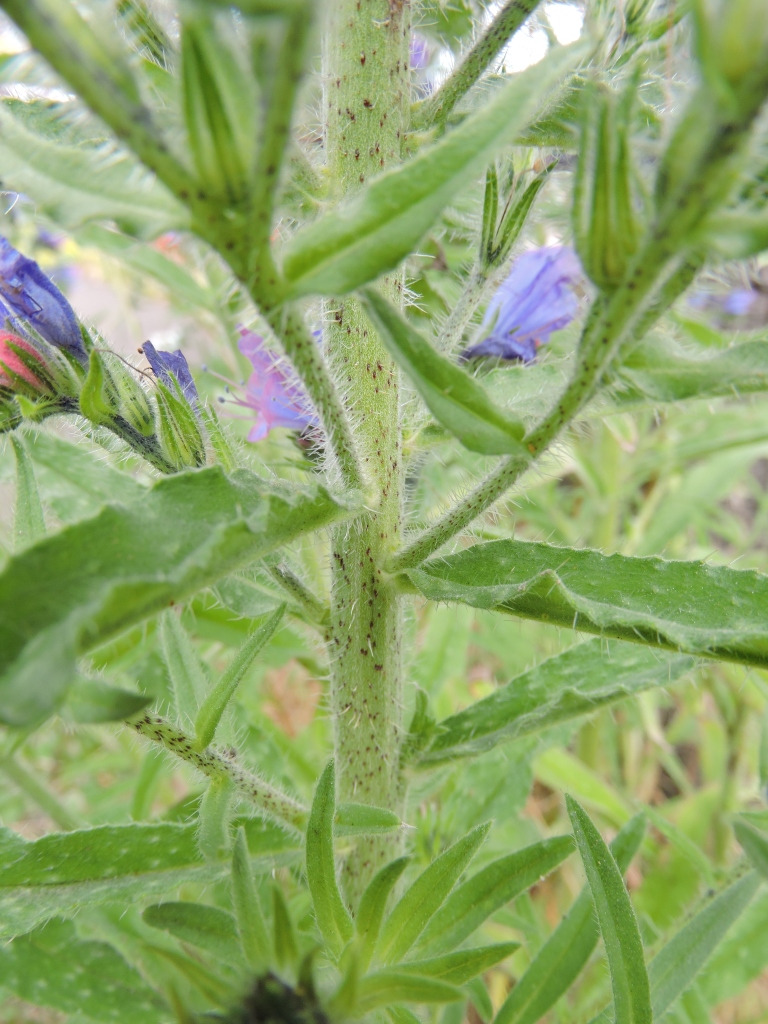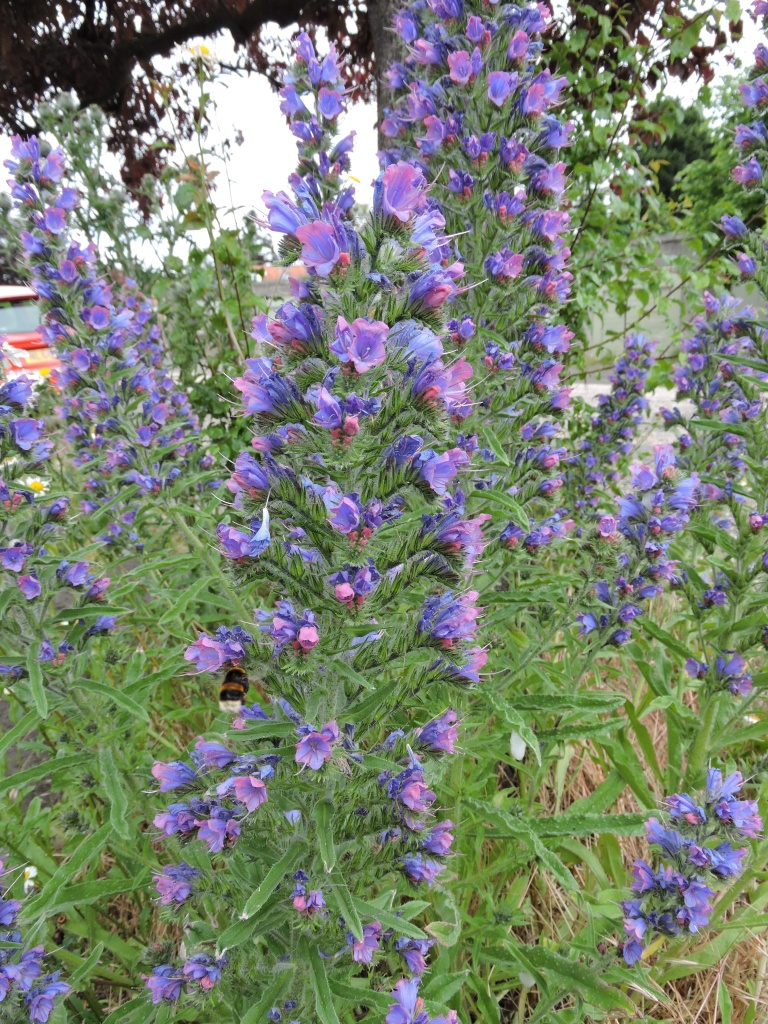Coming around the curve of the road, there came into view a wonderfully wild garden, full of ox-eye daisies (Leucanthemum vulgare) and red campion (Silene dioica), and spilling out the front of it onto the street, tall flowering spikes of viper’s bugloss (Echium vulgare). The plants had managed to self-seed into the tree-planting square opposite, too, along with the daisies, making this patch of pavement look more like a path through a garden than a street. Plants improve a walk no end!

Not all examples of this plant are so impressive; an E. vulgare I came across on the well-trodden side of Arthur’s Seat in Edinburgh a week later showed how different a plant can appear depending on its growing conditions. Thin soil, exposure and foot traffic had made the plant low-growing and dusty, but the flowers were still that noticeable rich blue. Other specimens growing on the rock faces alongside the Radical Road showed the more typical elongated flowing spike, and on this hot, sunny day, gave the craggy slopes a slight Mediterranean/Macaronesian feel.

Low- growing E. vulgare 
E. vulgare growing on a rock face at Arthur’s Seat
These flower spikes develop in the plant’s second year; its first year of growth is spent as a rosette of bristly, linear leaves. These leaves can be flecked with pale markings and have an obvious midrib running their length. The flower spike grows up to about 90cm tall, with stem leaves running up it that reduce in size as they become interspersed with flower clusters towards the upper part. These clusters are typical of the family E. vulgare is in, the Boraginaceae: a coiled cluster with the flowers closest to the stem opening first. These inflorescences are also known as scorpioid cymes, and you can see the similarity between those of E. vulgare and other members of the Boraginaceae such as forget-me-nots (Myosotis species) and comfreys (Symphytum species). The flower colours are also a good feature of the family: viper’s bugloss flowers are pink in the bud, and, once opened, turn a rich blue as they mature.

They are funnel-shaped and most of the stamens protrude from the mouths of the flowers. They are insect-pollinated and are hugely popular with bumblebees, blooming between June and September before forming four nutlet fruits from each flower. The stem that bears these clusters is bristly, like the rest of the plant, and speckled with reddish spots or flecks. Being a biennial, the plant dies after producing seed – but it produces seed in copious quantities and is well-known for self-seeding vigorously.
The natural habitats of this species include coastal cliffs and dunes, and grassland, and it is also found in areas of open and disturbed land such as waste ground. It prefers sandy and calcareous soils. It is also a common garden plant and the cultivar ‘Blue Bedder’, which is bushier and has bluer flowers than the species, is available. It is native to Europe and temperate parts of Asia, with a wide range that includes the UK and Ireland, though in Ireland it is not common and is usually only to be found in coastal areas. As well as this, it has been introduced to and is naturalised in Australia, parts of North and South America, Canada, parts of North and South Africa and other parts of Asia. According to the Biological Records Centre, E. vulgare has declined somewhat in frequency in the UK because of the intensification of agriculture and changes in land use.

There are some interesting tales about this plant, tied up with its names. The generic name Echium derives from the Greek echis, meaning viper, while the specific epithet vulgare comes from the Latin vulgaris, meaning common. The common name bugloss is thought to have come from two Greek words: bous, meaning ox, and glossa, meaning tongue, supposedly comparing the roughness of the leaves to the roughness of an ox’s tongue.

The leaves are rough 
The stems are speckled with red
Why both the botanical and common names of viper’s bugloss refer to vipers is less clear. It was apparently used as a treatment for snake bites back in the day, though did this lead to its name or was it because of it? Other theories are that the nutlets resemble an adder’s (Vipera beris) head; that the red speckles on the stem are reminiscent of the markings on an adder’s skin; and that the stamens that emerge from the flowers look like snakes’ tongues.

The herbal written by Nicholas Culpeper says that the ‘seeds drank in wine produces an abundance of milk in nursing mothers,’ – but the benefits of the herb must surely be outweighed by risks associated with nursing women drinking alcohol…A modern alternative of boiling the seeds in water avoids this, but other sources of information warn against drinking teas made of this plant, due to the chemicals contained in the tissues. I am not sure if these compounds (pyrrolizadine alkaloids) are also found in the seeds. These alkaloids act as a poison in the liver if they are ingested over time. The hispid (bristly) surface of the leaves and stems can cause contact dermatitis in some people.
Figure 21 from Deutschlands Flora in Abbildungen at http://www.biolib.de; public domain
Regardless of any medical uses it may or may not have, viper’s bugloss is an attractive species to include in your garden, especially if you want to bring in the bees!

References
– First Nature, 2021. Echium vulgare – Viper’s Bugloss
https://www.first-nature.com/flowers/echium-vulgare.php
– Gerard, J (Ed. Woodward, M.) 1985. Gerard’s Herbal. Bracken Books
– Missouri Botanic Garden, n.d. Echium vulgare http://www.missouribotanicalgarden.org/PlantFinder/PlantFinderDetails.aspx?taxonid=277970
– Online Atlas of the British and Irish Flora, 2021. https://www.brc.ac.uk/plantatlas/plant/echium-vulgare
– Plants For A Future, 2021. Echium vulgare – L. [online] Available at: https://pfaf.org/USER/Plant.aspx?LatinName=Echium+vulgare
– Royal Botanic Garden Kew, n.d. Echium vulgare L. http://www.plantsoftheworldonline.org/taxon/urn:lsid:ipni.org:names:115950-1
– Rose, F, 2006. The Wild Flower Key. Frederick Warne
– Streeter, D et al. 2009. Collins Flower Guide. Collins
– Wink, M. and van-Wyk, B. 2008. Mind-altering and Poisonous Plants of the World. Timber Press
– text and images (unless otherwise attributed) by Heather Forbes


